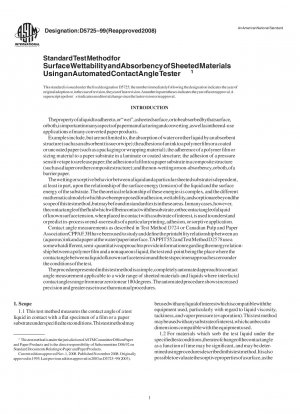ASTM D5725-99(2008)
Standard Test Method for Surface Wettability and Absorbency of Sheeted Materials Using an Automated Contact Angle Tester
- Standard No.
- ASTM D5725-99(2008)
- Release Date
- 1999
- Published By
- American Society for Testing and Materials (ASTM)
- Status
- 2010-08
- Latest
- ASTM D5725-99(2008)
- Scope
Contact angle measurements may be used to study the relative sorbtive rates of uncoated sorbent papers, or the relative printing or writing characteristics of coated or sized printing and writing papers.
The complex interaction between a liquid and a surface may be looked upon as a combination of three different processes of wetting, absorption, and adsorption. Wetting is best explained with a drop of water on a plastic film. The liquid volume remains the same, the drop base diameter will increase, and the contact angle will decrease as a function of time. When the liquid volume is reduced as a function of time, the base diameter of the drop is studied. When this diameter remains constant, the absorption is dominating. When the drop is spreading across the surface (increasing base diameter), the interaction is based on adsorption.
For sized papers, an increase in feathering is likely as the rate of change in the contact angle with time increases, indicating a relative increased degree of liquid transport or penetration (absorption) into the paper.
For sorbent papers, the change in contact angle with time may be very rapid, with those papers showing the greater relative change per unit time having the fastest rate of sorption.
For hard sized papers, little change in contact angle with time may be seen, and for laminates or polymer coated and barrier papers, release papers, or other similar specialty grades, there may be no change in contact angle over the time interval of a typical test.
It is generally found that papers having contact angles with water-based inks in the range 90 to 110° work best in printing and writing applications. Feathering may be expected for contact angles less than 90°. Breaks in the flow of ink onto the paper may occur for contact angles greater than 110°.
Because of the wide range of paper coating possibilities and ink compositions, further generalizations are difficult. However, contact angle is a precise empirical tool for use in studying specific liquid/substrate combinations for product and process improvements.
In addition, contact angle measurements on films are used to determine printing and gluing characteristics of films with specific printing inks or adhesives. In such applications, the procedure may use a constant film substrate with various test liquids of significance to a specific end-use application. By measuring substrate surface free energy and then monitoring and controlling any surface treatment of the material using contact angle measurements, improved end-use performance in gluing or printing applications is possible.
1.1 This test method measures the contact angle of a test liquid in contact with a flat specimen of a film or a paper substrate under specified test conditions. This test method may be used with any liquid of interest which is compatible with the equipment used, particularly with regard to liquid viscosity, tackiness, and vapor pressure (evaporation). This test method may be used with any substrate of interest, which can be cut to dimensions compatible with the equipment used.
1.2 For materials which sorb the test liquid under the specified test conditions, the rate of change of the contact angle as a function of time may be significant, and may be determined using procedures described in this test method. It is also possible to evaluate the sorptive properties of a surface, as the remaining liquid volume on top of the specimen surface is measured as a function of time.
1.3 The conditions required in this test method specify reagent water as the test liquid when testing papers designed to be absorbent, such as absorbent tissue grades.
1.4 Condit......
ASTM D5725-99(2008) Referenced Document
- ASTM D1193 Standard Specification for Reagent Water
- ASTM D1968 Standard Terminology Relating to Paper and Paper Products
- ASTM D2578 Standard Test Method for Wetting Tension of Polyethylene and Polypropylene Films
- ASTM D5039 Standard Test Methods for Identification of Wire Side of Paper
- ASTM D528 Standard Test Method for Machine Direction of Paper and Paperboard
- ASTM D585 Standard Practice for Sampling and Accepting a Single Lot of Paper, Paperboard, Fiberboard, and Related Product
- ASTM D685 Standard Practice for Conditioning Paper and Paper Products for Testing
- ASTM D724 Standard Test Method for Surface Wettability of Paper (Angle-of-Contact Method)
- ASTM E122 Standard Practice for Calculating Sample Size to Estimate, With a Specified Tolerable Error, the Average for Characteristic of a Lot or Process*, 2000-10-10 Update
- ASTM E691 Standard Practice for Conducting an Interlaboratory Study to Determine the Precision of a Test Method
ASTM D5725-99(2008) history
- 1999 ASTM D5725-99(2008) Standard Test Method for Surface Wettability and Absorbency of Sheeted Materials Using an Automated Contact Angle Tester
- 1999 ASTM D5725-99(2003) Standard Test Method for Surface Wettability and Absorbency of Sheeted Materials Using an Automated Contact Angle Tester
- 1999 ASTM D5725-99 Standard Test Method for Surface Wettability and Absorbency of Sheeted Materials Using an Automated Contact Angle Tester
